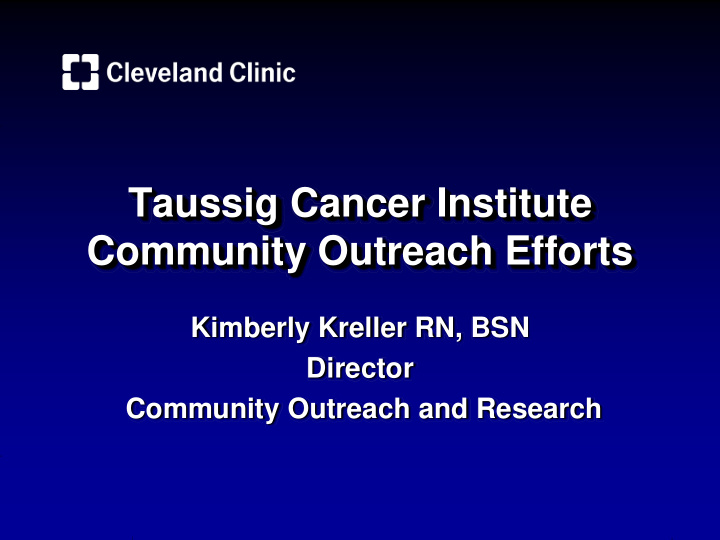



Taussig Cancer Institute Community Outreach Efforts Kimberly Kreller RN, BSN Director Community Outreach and Research
Team Members • Dr. Marc Shapiro, Medical Director • Angela Bailey • Stacey Booker, RN MSN • MaryAnne Ott
Disparities of Health Defined as the differences in: • Incidence • Prevalence • Mortality • Burden of Disease Among specific population groups
Cancer: Disparities Overview • African Americans • Latinos • Native Americans • White Impoverished • Older Aged Population
Affected Groups with Worse Cancer Outcomes • African Americans more likely than Caucasians to be diagnosed with malignant cancers • Overall decreases in cancer death rates over past decade, but age-adjusted total cancer mortality higher in African Americans • African Americans less likely to be diagnosed with cancer at early stage and less likely to survive five years after diagnosis
Contributing Factors Suspicion of the medical establishment • Lack of education (general and regarding cancer) • Lack of resources • - Health insurance - Money - Family support Medical Establishment – Major Issues • - Distribution of physicians - Lack of cultural diversity - Those available to under-served may not have time or experience regarding cancer advances
Race to Reducing Disparities Build Trust Eliminate Fear Increase Awareness Provide Resources Resolve Barriers
Why Navigation Works Without Navigation With Navigation No follow up after initial Coordinated plan of care diagnosis (2007) Received financial Cancer progressed to stage assistance 4 with metastasis (2009) Connected to Healthcare No identified medical home system/PCP “If I ignore, it will go away” Transportation arranged “ I didn’t have no support” Referral to cancer support group at Huron Hospital
Patient Navigation Model Patient Navigation Patient Navigation Outreach Rehabilitation Resolution Abnormal Finding Abnormal Diagnosis Treatment Results Navigation Conclude Freeman, et.al., Cancer Practice , 1995.
Patient Navigation Program • Elimination of barriers to care • Timely diagnosis and treatment • One of five national cancer centers • Follows the Patient Navigation Model developed by Harold P. Freeman. MD • Certified Patient Navigators
Patient Demographics • 140 navigated • 31% male; 69% female • 5% Caucasian; 95% African American • Insurance Status - 38% Medicare - 28% Medicaid - 27% Uninsured - 6% Private
Barrier Resolution Barrier Number Number Identified Resolved Financial 54 50 Insurance Medication Psycho/Social 14 14 Support Housing Service Delivery 1 1 Scheduling Other 30 30 Transportation Homecare
Beauty and Barbershop Programs • Community talking to one another • Engage the community to engage one another • The community delivers the message • Trust built and fear eliminated • Access to screening services • Link to Patient Navigation Program
Beauty and Barbershop Program Goals • Increase the amount of programming • Quantify efforts • Provide pre-test, post test and retest • Provide and report out results • Demonstrate and increase in knowledge • Reduce the lack of education as a contributing factor to disparity of care
Geriatric Oncology Program • Program launched in July 2009 • Early stage of development (TOPS) • Three physician leaders with expertise in geriatrics, oncology, pharmacology and palliative care • Comprehensive care to patients 75 years and older • Supportive care services for cancer symptoms or its treatment
The Finish Line Listen to the community Strengthen relations with our religious leaders Develop and sustain internal and external partnerships Continue to implement programs and initiatives that address disparities Remain in contact with our political leaders who are aware of the policies that impact what we do
Recommend
More recommend